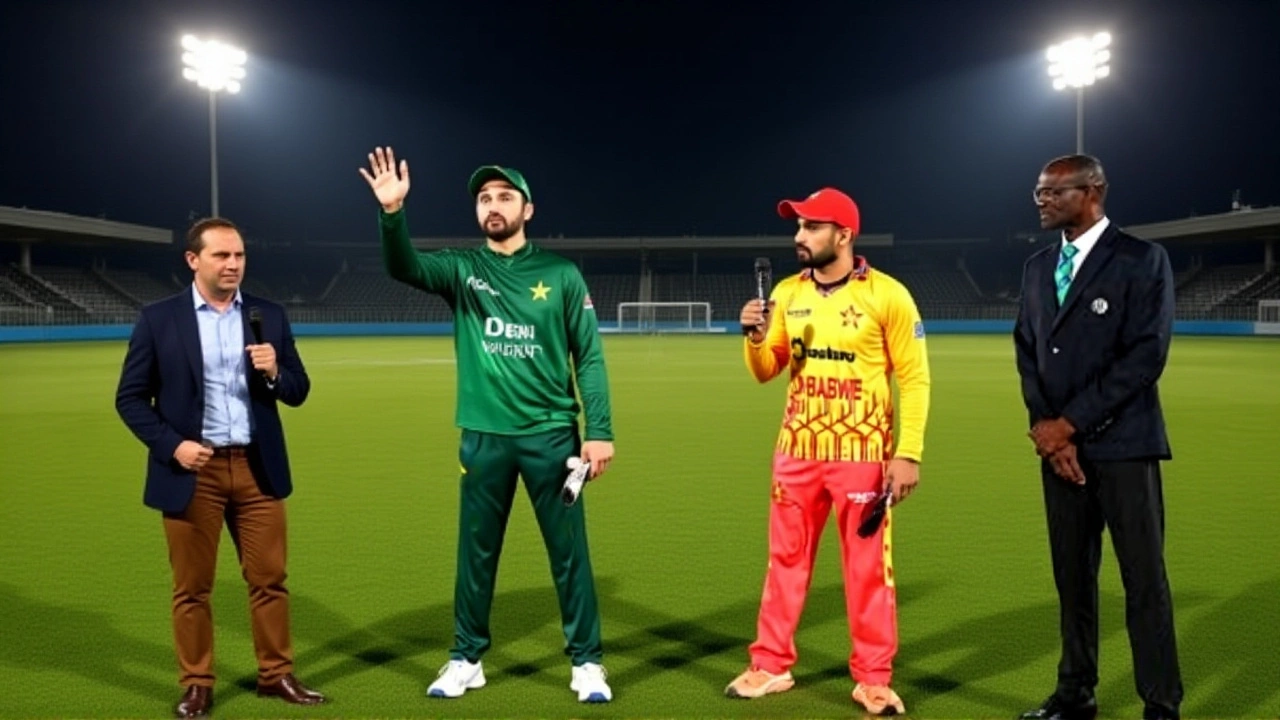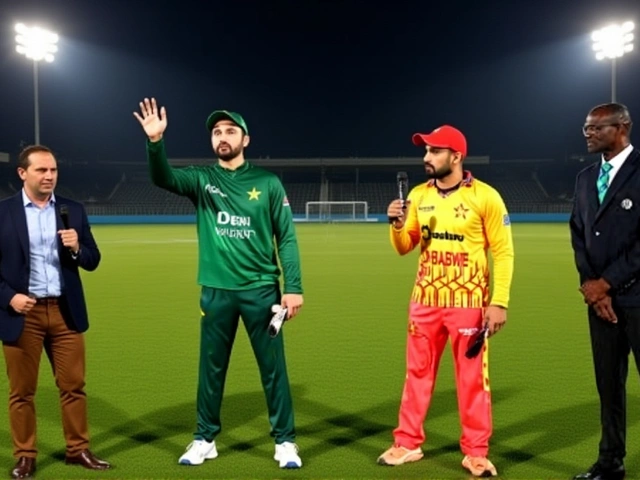On Sunday, November 23, 2025, Pakistan dismantled Zimbabwe by 69 runs at the Rawalpindi Cricket Stadium, sealing their place in the final of the 2025 T20 Tri-Series. The win wasn’t just a formality—it was a statement. Pakistan, already undefeated in the tournament, delivered a clinical performance that left Zimbabwe reeling, with their bowlers strangling the visitors’ chase and their batters setting a daunting total. This was the fourth match of the tri-series, and with it, Pakistan clinched their third straight victory, while Zimbabwe’s campaign ended in defeat after just one win. The final now looms: Pakistan versus Sri Lanka, a clash of contrasting styles and momentum.
Domination from the Start
Pakistan didn’t just win—they owned the game from the first over. Opening batsmen Saim Ayub and Sahibzada Farhan laid a solid foundation, with Farhan playing the anchor role once again, following his 80-run knock against Sri Lanka just a day earlier. Zimbabwe’s tall fast bowler Richard Ngarava, known for his back-of-a-length deliveries and extra bounce, started aggressively, but Farhan’s calmness neutralized the threat. By the time Farhan fell for 67, Pakistan had raced to 142 for 2 in 14 overs. What followed was a brutal middle-order assault: Mohammad Nawaz, who’d taken 3 wickets against Sri Lanka, smashed 21 off 12 balls, while Usman Khan (wicketkeeper) added a brisk 29. Pakistan finished at 198 for 5, a total that looked massive on a pitch offering slight turn and uneven bounce.
Zimbabwe’s Collapse
Chasing 199 in 20 overs, Zimbabwe never looked in control. Their openers, Brian Bennett and Tadiwanashe Marumani, were both gone inside the first 3 overs—Bennett skied a catch for just 9, and Marumani was bowled by a searing yorker from Shaheen Shah Afridi. At 14 for 2, the writing was on the wall. Captain Sikandar Raza, Zimbabwe’s most experienced batter, tried to steady the ship with a stylish flick for two, but the pressure mounted. Haris Rauf and Naseem Shah exploited the conditions ruthlessly, with Rauf’s leg-cutter trapping Ryan Burl lbw and Naseem clean-bowling Tashinga Musekiwa with a reverse-swinging delivery. By the 15th over, Zimbabwe was 98 for 7. Even Sikandar Raza’s gritty 41 couldn’t stem the tide. They were all out for 129 in 18.4 overs, their lowest total in the tournament.
Why This Matters
This wasn’t just about advancing to the final. For Pakistan, it was about momentum. With the ICC T20 World Cup just months away, the PCB used this tri-series as a high-stakes rehearsal. Babar Azam’s leadership was calm, the pace attack—Afridi, Rauf, Naseem—showed lethal precision, and the middle order, often a weakness, delivered under pressure. For Zimbabwe, it was another reminder of the chasm between Test-playing nations and emerging teams. They’ve shown flashes—like their win over Sri Lanka—but consistency remains elusive. Their reliance on Raza and the lack of depth in batting was glaring.
Behind the Scenes: Broadcasts and Logistics
The match kicked off at 6:30 PM IST, streamed live on the Sports TV YouTube Channel for Indian viewers, while U.S. audiences tuned in via Willow TV at 8:00 AM ET. Despite reports from The Indian Express suggesting no traditional TV broadcast in Pakistan or Zimbabwe, digital access remained robust. The Pakistan Cricket Board had strategically scheduled the tri-series in Rawalpindi to maximize local fan engagement and test conditions similar to those expected in future international venues. The stadium, packed with over 25,000 fans, echoed with chants of “Pakistan Zindabad” as the final wicket fell.
What’s Next: Final Showdown
Pakistan now faces Sri Lanka in the final, scheduled for November 25, 2025, at the same venue. Sri Lanka, who lost to Pakistan by 7 wickets and beat Zimbabwe, enter as the underdogs but with a more experienced core—especially in spin. Pakistan’s biggest challenge? Resting key bowlers like Afridi and Rauf, who’ve bowled heavy overs in both wins. If Babar Azam opts for rotation, it could open doors for fringe players like Abdul Samad or Usama Mir to shine on the biggest stage.
Tournament Snapshot
- Pakistan: 3 wins, 0 losses — 6 points (qualified for final)
- Sri Lanka: 1 win, 1 loss — 2 points (qualified for final)
- Zimbabwe: 1 win, 2 losses — 2 points (eliminated)
Only the top two teams advanced. Pakistan’s perfect record makes them favorites, but Sri Lanka’s ability to chase under pressure—evident in their win over Zimbabwe—means the final won’t be a formality.
Frequently Asked Questions
How did Pakistan’s bowling attack perform in the match?
Pakistan’s pace trio—Shaheen Shah Afridi, Haris Rauf, and Naseem Shah—combined for 7 of Zimbabwe’s 10 wickets. Afridi opened with fiery pace, removing both openers early. Rauf’s leg-cutters and reverse swing in the middle overs were devastating, while Naseem’s control under pressure sealed the win. Their economy rate of 6.8 runs per over was the lowest in the tournament for any team in a single match.
Why was this match streamed online instead of on TV in Pakistan and Zimbabwe?
Though traditional broadcast rights weren’t secured by major networks in Pakistan and Zimbabwe, the Pakistan Cricket Board prioritized digital access to reach younger audiences and global diaspora. The Sports TV YouTube Channel and Willow TV offered free streaming, ensuring broader reach than a limited TV broadcast would have. This reflects a growing trend among cricket boards to bypass traditional TV deals in favor of direct-to-fan platforms.
Who were the standout performers for Pakistan beyond the captain?
Beyond Babar Azam, Sahibzada Farhan (67) anchored the innings, while Mohammad Nawaz’s explosive 21 off 12 balls gave Pakistan crucial late momentum. In the bowling department, Haris Rauf took 3 for 21 in 4 overs, and Naseem Shah’s 2 for 18 included a crucial wicket of Sikandar Raza. Usman Khan also contributed with a quick 29 at the death, showing depth beyond the top order.
What does this result mean for Zimbabwe’s cricket future?
Zimbabwe’s lone win over Sri Lanka showed potential, but their batting collapse against Pakistan exposed a deep lack of depth. Only Sikandar Raza and Ryan Burl consistently performed. Without a strong domestic structure or consistent funding, their ability to compete with top-tier teams remains limited. This loss may accelerate calls for reform within the Zimbabwe Cricket board, especially regarding player development and financial stability.
How does this tri-series impact Pakistan’s World Cup preparations?
The tri-series served as a perfect stress test. Pakistan confirmed their top order stability, found reliable finishers, and tested their death bowling under pressure—all key areas for the World Cup. The fact that they won all three matches without needing to rely on one player (like Shaheen or Babar alone) suggests improved balance. If they maintain this form, they’re serious contenders for the T20 World Cup in June 2026.
What’s the historical significance of Pakistan’s win at Rawalpindi Cricket Stadium?
Rawalpindi has been a fortress for Pakistan in T20s, with a win rate of over 80% since 2018. This was their seventh consecutive T20 win at the venue, extending their dominance. The crowd’s energy, combined with the pitch’s slightly slower nature, favors Pakistan’s spin and pace combo. Historically, teams that win here tend to carry momentum into global tournaments—making this win more than just a tri-series result.

